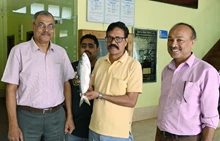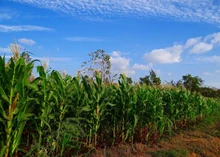
Sea buckthorn (Hippophae L.) is a Himalayan shrub with immense pharmacological and commercial benefits. Its fruits are rich in antioxidants and have shown anti-inflammatory, anti-carcinogenic, and anti-atherosclerotic properties. With its late maturing attribute, sea buckthorn offers interest as an ornamental bush. In India, sea buckthorn naturally thrives in various regions, including Jammu and Kashmir, Himachal Pradesh, Uttarakhand, Sikkim, and Arunachal Pradesh. In 2023, the Geographical Indication Registry officially awarded the GI tag to 'Ladakh Sea Buckthorn,' making it the fourth product in Ladakh to receive this recognition.
Sowing Time
Sea buckthorn is mainly sown between October and November or late February.
Climate and Soil
-
The Ladakh region of the Indian continent, known for extreme climatic conditions, is ideal for cultivating sea buckthorn with temperatures ranging from -30°C to +35°C. This hardy bush can tolerate even harsher extreme temperatures of range -40°C to +40 °C. Additionally, adequate sunlight is crucial for sea buckthorns to thrive, especially for fruit production in female plants. They require a sunny location without shade from other trees to ensure optimal growth and fruit-bearing.
-
It requires a smooth soil surface, free of stones or hard rocks, with an optimal depth of 2-3 meters for proper root growth. Mainly airy, sandy soils, slightly acidic or alkaline are preferred. Mix heavy soils with 1/3 sand for aeration. Adjust the mix based on soil type; for very sandy soil, use a 1:1 mix with potting soil to improve yields.
-
Its extensive root system binds soil particles, aids in nitrogen fixation, and enhances soil health. Sea buckthorn is versatile, thriving in arable and marginal soils, and is tolerant to salt spray near highways.
Planting Method
-
Planting in hedge row systems, either single or double, is recommended, providing adequate spacing between rows (1 meter) and plants. The distance between rows varies based on cultivation type and intercropping needs.
-
Autumn (October-end to early November) and spring (March-April) are ideal for pit digging and planting. Pits should be 60 cm in diameter and 60-80 cm deep, with well-rotted FYM added before filling.
-
Solarization of pits for 10-15 days is recommended, followed by proper filling with the prepared mixture, including sand for soil porosity balance, especially in heavy soils.
Irrigation
Sea buckthorn is highly drought-tolerant, requiring minimal watering once established. However, potted sea buckthorn may need occasional watering during hot summers to prevent soil drying. Avoid waterlogging, as the plant is sensitive to excess moisture.
Training and Pruning
-
Training is vital to shape sea buckthorn plants for easier cultural operations and to establish a strong, scientific structure. Due to its thorny nature, the plant should be kept under 2 meters in height for convenient harvesting. Properly managed plants develop a crown with a diameter of 2-3 meters by the age of 4 years.
-
Pruning is essential for canopy management, sucker removal, and stimulating new growth to induce flower buds for the next season. The best time for pruning in Ladakh is March, before spring sprouting. The intensity of pruning depends on plant age, growth, and soil conditions, with typically 50% of 3-4 year old shoots removed.
Propagation
-
Seeds - The seeds are small, brownish, and around 4.5 mm long, with a hard coat. Each gram contains about 100–105 seeds, viable for up to 2 years for propagation.
-
Suckers - Sea buckthorn can be propagated through suckers, yielding 13–40 per plant. Suckers, true to the parent plant, are separated with roots and planted directly at the site preferably in March before bud break.
-
Hardwood Cuttings - Stem cutting is recommended in March. Cuttings, pencil-thick and 1–2 years old, are prepared by removing side branches and thorns. After washing for 2–3 days, they are treated with indole butyric acid (IBA) @500 ppm before planting to aid rooting, taking 60–75 days. This method ensures proper canopy development and maintains the orchard's male/female ratio.
-
Softwood Cutting - Softwood cuttings yield over 90% rooting with excellent root quality, especially under mist conditions using coarse sand. Cuttings are treated with NAA @200–300 ppm. Plantlets are transplanted into polybags within 90–100 days after planting.
Crop Protection
-
Sea buckthorn diseases include Verticillium wilt, Fusarium wilt, and Rust, causing leaf discoloration and plant withering.
-
Pest threats include Aphids, San Jose scale, and Gypsy moth, damaging leaves and fruit. Control involves pruning, burning affected plants, and using horticultural oils.
-
Nematodes and mites affect plant growth, requiring resistant varieties and soil disinfection for control. Cockchafer larvae lead to wilting, necessitating soil mobilization, and insecticide treatment.
-
Short, preventive measures include careful inspection of planting material and weed control.
Harvesting and Yield
-
Vegetatively propagated sea buckthorn plants start bearing fruit at 3–4 years, while seedlings take 5–6 years. Commercial production begins in orchards after 8 years of planting.
-
Cultivated varieties yield 10–15 tonnes/ha of fruit under proper orchard management. In Ladakh, ripe fruit yield ranges from 0.6–2.0 kg/plant due to wild growth conditions. Approximately 200–300 q of fresh leaves can be harvested per hectare per year after 8 years of planting.
Uses
-
Sea buckthorn berries are rich in beta-carotene, vitamins C, E, and B12, offering anti-inflammatory properties and immune-boosting benefits.
-
Consuming sea buckthorn juice is recommended during pregnancy for its vitamin content. While safe to eat raw, they're most flavorful when cooked.
-
They're versatile in the kitchen, used in purees, juices, jams, syrups, and liqueurs. Dried berries make delicious tea or powder. Sea buckthorn oil, extracted from the berries, is popular in cosmetics.










